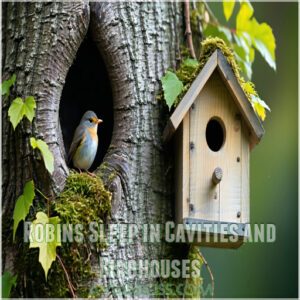This site is supported by our readers. We may earn a commission, at no cost to you, if you purchase through links.
 Robins are resourceful sleepers, and where they rest depends on the season and their needs.
Robins are resourceful sleepers, and where they rest depends on the season and their needs.
During the breeding season, females sleep in nests to keep their eggs warm, but once the chicks are older, they’ll abandon the nest.
Outside of breeding, robins often choose sheltered spots like thick shrubs, dense vegetation, or even cavities in trees or birdhouses.
During migration, they gather in large communal roosts for warmth and safety, sometimes packing in the thousands.
Robins prioritize protection from predators and harsh weather, often picking locations near food and water.
Curious about robin sleeping quirks? There’s more to uncover about their sleeping habits!
Table Of Contents
- Key Takeaways
- Where Do Robins Sleep at Night?
- Robins Sleep in Nests During The Breeding Season
- Robins Sleep in Communal Roosts During Migration
- Robins Sleep in Cavities and Birdhouses
- Robins Sleep in Nest Boxes During Winter
- Robins Sleep in Thick Vegetation for Protection
- Robins Sleep in Groups for Warmth and Safety
- Robins Sleep With Their Heads Tucked Under Their Wings
- Robins Sleep for 12-14 Hours Per Day
- Frequently Asked Questions (FAQs)
- Where do Robins sleep?
- Do Robins sleep together?
- Do Robins sleep on trees?
- Do Robins sleep in log piles?
- How do Robins choose a sleeping spot?
- Do Robins sleep in nests?
- Where do robin birds go at night?
- Do robins recognize humans?
- Do mother robins sleep with their babies at night?
- What is the life span of a robin?
- Conclusion
Key Takeaways
- You’ll find robins sleeping in trees, shrubs, and hidden nooks like tree cavities or birdhouses, prioritizing safety and warmth.
- During winter, robins gather in communal roosts to conserve heat and stay protected, often grouping in evergreens or urban settings.
- Female robins sleep in nests only during the breeding season to keep eggs warm but move to nearby branches once the chicks are older.
- Robins choose sheltered spots with dense foliage or vegetation to stay hidden from predators and shielded from harsh weather.
Where Do Robins Sleep at Night?
When night falls, you’ll find robins seeking refuge in a variety of surprising places.
These adaptable birds display fascinating robin sleeping habits, choosing secure spots like dense Tree Canopies and Urban Roosts for their nightly rest.
During breeding season, female robins stay vigilant on their nests while males gather at communal roosting sites, often hidden among Garden Shrubs or along Fence Lines.
You might spot these clever birds tucking themselves into Evergreen Trees when temperatures drop, as robin nighttime behavior prioritizes both warmth and safety.
Their preferred robin roosting locations include sheltered spots next to buildings or deep within foliage.
As you observe robins in trees at night, you’ll notice they’re masters at finding protected perches that shield them from predators and harsh weather.
Robins Sleep in Nests During The Breeding Season
You’ll find female robins sleeping in their nests only during the breeding season when they’re keeping their eggs warm.
Once their chicks are about a week old, they’ll return to sleeping on nearby tree branches, leaving the nest just for their growing babies.
They do this change in behavior presumably because the nest is now only for their offspring.
Nest Construction
Female robins are master architects, crafting their nests with precision and care during breeding season.
Their nest architecture showcases remarkable skill in branch selection and construction. Here’s how these feathered builders create their cozy homes:
- They assess multiple locations, choosing sturdy branches hidden from predators
- The female robin spends 2-6 days building each nest
- She makes hundreds of trips gathering materials
- The construction forms a sturdy foundation that’s 3-8 inches wide
These robin nesting spots become safe havens where they’ll spend countless nights during breeding season.
The robins’ careful selection of materials and construction techniques is influenced by their understanding of nest construction process to build a safe home.
Nest Materials
A robin’s nest is like a carefully crafted masterpiece, built with materials that provide both comfort and protection.
These remarkable birds gather specific items to create their cozy sleeping quarters:
- Dried grasses form the foundation, providing structure and insulation
- Small twigs interweave to create sturdy walls that withstand wind
- Sticky mud acts as natural cement, binding everything together
- Soft feathers line the interior for warmth during chilly nights
- Fresh leaves help camouflage the nest from predators’ eyes
Each material serves an important purpose in creating these safe havens where robins rest peacefully.
The selection of these materials is essential, often involving the use of bird nesting materials to construct the perfect nest.
Nest Placement
When choosing nest locations, robins carefully select spots protected from sun, wind, and rain.
You’ll find their nests tucked away near prime feeding areas with easy access to water.
These clever birds favor open nest boxes and quiet spaces, often settling in log piles, tree trunk hollows, and dense hedges.
They’ve even been known to build in quirky spots like kettles, flower pots, and unused boots, which can be considered prime feeding areas.
Robins Sleep in Communal Roosts During Migration
When winter’s chill approaches, robins showcase remarkable migration patterns by gathering in large communal roosts during their journey south.
You’ll find these winter robin roosts housing thousands of birds, all seeking warmth and protection together. During robin migration sleep, they travel in loose flocks, covering impressive distances of 100-200 miles per day at speeds of 30-36 mph.
These roosting strategies aren’t just about rest – they’re sophisticated survival techniques. In their winter habitats, robins demonstrate fascinating flock behavior by sharing resources and looking out for each other.
Their communal safety strategy means more eyes watching for predators and more bodies generating essential warmth during cold nights. Robins also employ effective bird warming methods to conserve energy.
Think of a robin roost as nature’s version of a crowded hostel – everyone bands together, sharing body heat and security. These clever robin sleep adaptations help them conserve energy and navigate their long journeys successfully, proving that sometimes the best survival strategy is simply sticking together.
Robins Sleep in Cavities and Birdhouses
When it’s time to rest, robins don’t just pick random spots—they’re strategic.
Many seek tree cavities and birdhouses as their perfect sleeping hideaways.
These spots provide both warmth and protection from predators and unpredictable weather.
If you’ve ever wondered where robins go after their busy day, they might be tucked away in these cozy nooks.
To make the cut, a cavity or birdhouse needs the right features:
- Openings: Ideal size is 2-3 inches wide for robins.
- Placement: Elevated 5-10 feet in quiet, safe areas to stay undisturbed.
- Warm lining: Moss, leaves, or grass act as natural insulation.
- Shared spaces: Robins may roost communally in larger shelters.
- Adaptability: Even garden sheds or eaves can become robin roosts.
When you spot an old roosting box or well-placed nesting shelf, imagine a robin happily snoozing there, blending survival with cozy charm.
Robins often prefer bird houses designs that provide them with the necessary protection and
Robins Sleep in Nest Boxes During Winter
When temperatures drop, offering a nest box transforms your yard into a safe haven for wintering robins.
These cozy shelters are perfect for robin sleeping habits, providing protection during cold weather and storms. Place the box 5-10 feet high, facing away from harsh winds, and allow airflow with tiny ventilation holes.
Robins use winter roosts like these to conserve energy for daytime foraging. Annual cleaning is key to keeping nesting boxes parasite-free.
It’s an easy way to support robin winter survival in urban habitats. Robins often rely on a Winter Robin Nest to survive harsh weather conditions, making a nest box a crucial wintering resource.
Robins Sleep in Thick Vegetation for Protection
When dusk settles, robins retreat to sheltered spots hidden in thick foliage or dense shrubs.
These areas offer safety from robin night predators like cats and hawks while also shielding them from harsh weather. It’s like their own natural fortress—simple, effective, and clever.
Here are the top spots where robins sleep at night:
- Evergreen Trees: Perfect for staying warm during colder months.
- Urban Roosts: In cities, they adapt, finding rest under eaves or even in bushes.
- Dense Shrubs: These provide excellent camouflage, blending with their surroundings.
Summer robin roosts might include leafy backyard hedges. Whether it’s robins sleeping in bushes or trees, their instincts for safety and comfort always guide them toward smart choices for the night.
Robins Sleep in Groups for Warmth and Safety
When robins sleep in groups, it’s a fascinating blend of smart survival and flock behavior.
This communal roosting helps robins conserve body heat during cold nights, fundamentally creating a shared "living blanket" for warmth. Think of it as nature’s version of teamwork—every bird benefits from the group effort!
Safety is another reason for this behavior. By roosting as a flock, robins can rely on multiple watchful eyes and sharp ears to detect predators. It’s like a round-the-clock security system, offering group safety while they rest.
These group roosts, whether it’s in dense shrubs or trees, are key parts of robin sleeping habits. Summer robin roosts might see smaller gatherings compared to the larger robin roosts in winter. Offering thick vegetation or berry-producing plants in your yard can encourage this fascinating communal behavior in your environment.
Robins Sleep With Their Heads Tucked Under Their Wings
Robins have a unique way of staying cozy at night: they tuck their heads under their wings, a sleeping posture that’s both practical and endearing.
This behavior helps them conserve heat, stay balanced, and protect their delicate faces.
Here’s why it’s so clever:
- Keeps body heat in check during cold nights.
- Protects their sensitive eyes and face from predators.
- Reduces distractions by muffling ambient noise.
- Supports balance while perched.
Robin sleep patterns and wing-tucking show nature’s brilliance!
Robins Sleep for 12-14 Hours Per Day
Despite their reputation as early birds, robins are real sleep enthusiasts, clocking an impressive 12-14 hours of rest each day.
Their sleep patterns revolve around natural light, so they settle in just after sunset and wake with the first glimmers of dawn.
During winter’s longer nights, their nocturnal rest can stretch closer to 14 hours, helping them conserve energy when the temperatures drop.
Robins don’t just snooze through the night.
Their daily routines include light periods of rest where they wake briefly to check for predators, a clever survival strategy that keeps them safe.
Robin sleeping habits are remarkable for their adaptability; they seek out hidden, sheltered spots like bushes, tree cavities, or even human-made spaces.
By understanding how robins sleep, you can help support these charming birds.
Encouraging dense vegetation or sheltered roosting spots provides much-needed protection for their restful nights.
Frequently Asked Questions (FAQs)
Where do Robins sleep?
At night, you’ll find robins snoozing in trees, dense shrubs, or human-made structures.
They pick hidden, cozy spots to dodge predators and weather.
In winter, communal roosts in evergreens help conserve warmth and stay safe.
Do Robins sleep together?
Picture a cozy slumber party in the wild—sometimes, robins do sleep together.
Especially in winter, they huddle in trees or shrubs, forming roosting flocks to conserve heat and stay safer from predators.
Do Robins sleep on trees?
You’ll often spot them tucked in trees, perched securely on branches or nestled within dense foliage.
Trees offer a cozy retreat, shielding robins from predators and weather while giving them a safe space to rest.
Do Robins sleep in log piles?
Robins can sleep in log piles if the environment offers enough protection.
Log piles provide shelter from predators and harsh weather, especially during colder months.
With thick cover, they’re a cozy option for roosting robins, offering a safe haven in harsh weather.
How do Robins choose a sleeping spot?
They pick spots offering safety and comfort, like dense shrubs or evergreen trees.
Shelter from weather and predators is critical.
In cities, they adapt, roosting under eaves or in cozy nooks near buildings.
Do Robins sleep in nests?
No, robins don’t typically sleep in nests unless they’re incubating eggs.
Nests act as cradles for young, not bedding.
Instead, robins sleep on branches or in sheltered spots safe from predators and weather.
Where do robin birds go at night?
At night, they tuck into trees, shrubs, or cozy corners like eaves and sheds.
Safety comes first—they hide from predators and harsh weather in dense foliage or sheltered spots, blending in like nature’s stealthy ninjas!
Do robins recognize humans?
Eyes are windows to the world, and robins notice yours.
While they can’t ‘recognize’ you scientifically, they’ll remember patterns—like feeders, your routine, or gestures—especially when food’s involved.
They’re smarter than they look, right, and will recall these patterns for food.
Do mother robins sleep with their babies at night?
Mother robins usually only sleep with their babies when they’re still nestlings to keep them warm and safe.
Once the chicks grow feathers, she roosts nearby on branches while the young stay in the nest.
What is the life span of a robin?
A robin’s life span averages around 2 years, though some beat the odds and live up to
Most don’t survive their first year due to predators, weather, or luck not being on their side.
Conclusion
Did you know robins can sleep up to 14 hours a day, depending on the season?
Understanding where robins sleep reveals their adaptability. From nests during breeding to communal roosts during migration or cozy spots like shrubs, cavities, and birdhouses, these birds prioritize safety and warmth.
Whether tucked under their wings in dense vegetation or gathering in groups, robins carefully choose their resting places. Next time you spot one, consider the thoughtful strategies behind their nightly routines.
- https://journeynorth.org/tm/robin/keep_warm_winter.html
- https://www.reddit.com/r/Ornithology/comments/1cbgo3j/how_deep_is_a_robins_sleep/
- https://www.allaboutbirds.org/guide/American_Robin/overview
- https://www.botanical-tales.com/wp-admin/post.php?post=152&action=edit
- https://www.woodlandtrust.org.uk/blog/2019/02/where-and-when-do-robins-nest/













